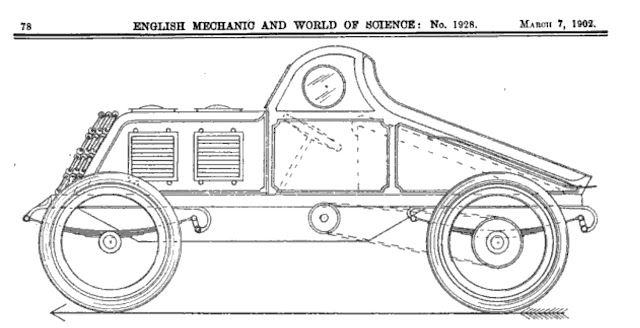 |
| The latest in racing car proposals in 1902 |
The car as described is certainly quite unlike anything else on the road back then, with its futuristic angular lines and streamlining. But what is really sets it apart is the driving position. The driver and mechanic lie down on their fronts on a padded, inclined couch protected on three sides and above by a cab. This brought to my mind parts of the late Sir Peter Ustinovs classic satirical recording "The Grand Prix of Gibraltar"
As the designer states in his letter to the editor. “The car would, behind the bonnet be of a wedge formation, thus reducing windage and vacuum troubles to a minimum”. He seems to know something about the concept of streamlining. The cab area would certainly offer protection from the buffeting winds the speeds would create, and if you required further protection from the elements, a canvas sheet would be drawn across the rear from the cab roof to the end of the car. He surmised that all this protection would make things more comfortable for the crew as they would not have to wear heavy coats, gloves and hats to keep them warm.
What about the pedals? How would you operate this novel vehicle? This is where things get a little vague, Mr Gawn only goes so far as to suggest that slots would be cut into the couch that the driver lies on. He considered that the area below the dashboard would be left open to the engine so that the driver and mechanic could keep an eye on things during running. Perhaps small adjustments and running repairs could be made too. This may well have resulted in quite the noisy cockpit at high speeds and high engine revs though.
As for the engine. What would power this car to victory? A four cylinder 50 HP unit is suggested in the letter. Horsepower to engine size calculations are complicated and way beyond my knowledge to work out. But a 1902 Napier Grand Prix car was said to develop 45 HP from a six and a half litre engine. I think it's fair to assume that the engine would need to be about 7 litres or 427 cubic inches at a minimum. Our designer wanted the power plant to be transversely mounted, with flywheels at each end of the crankcase, claiming that this would lead to greater stability than a similar car with a longitudinally mounted engine. Drive to the transmission, and wheels would be by chain.
The writer even says that he has shown this design to David J. Smith, supplier of parts for the English Mechanic cars. Smith was often referred to in the pages of the “English Mechanic” and was answering questions on the subject of car construction nearly every week. Clearly, he was seen as some kind of expert on the manufacture of early automobiles. Apparently Mr. Smith conceded that the idea had some merit and may well be a “goer” if a working pedal operation can be arranged, but the idea may be ahead of its time. Which in some aspects it is. The streamlined look and driving cab is like nothing else around then. But why Gawn chose to have the driver lay down on his front instead of reclining in a seat is beyond me. But this is the early days of the automobile and anything goes.
In closing, he asked for peoples opinions of the design, but I have yet to find a reply from any other readers of the magazine in the following issues.
The temptation to visualise what the vehicle may have looked like was too much for me, so I decided to dust off my iPad drawing skills and give it a go. The sketches are nothing but conjecture and a little bit of fun.
 |
| Artists impression showing the cockpit. Complete with padded couch. |
 |
| Artist’s impression of the car at speed. |
No comments:
Post a Comment